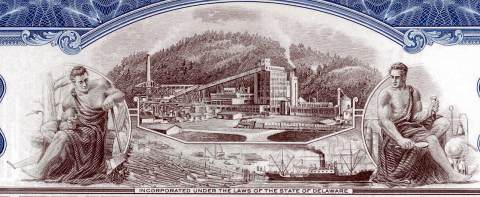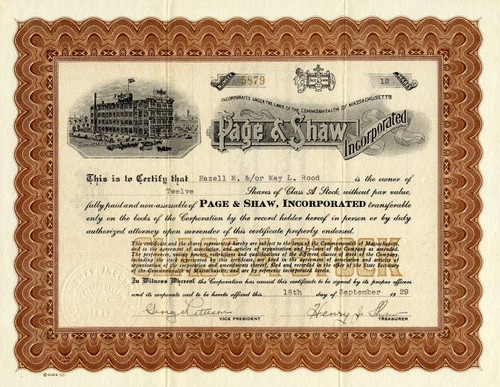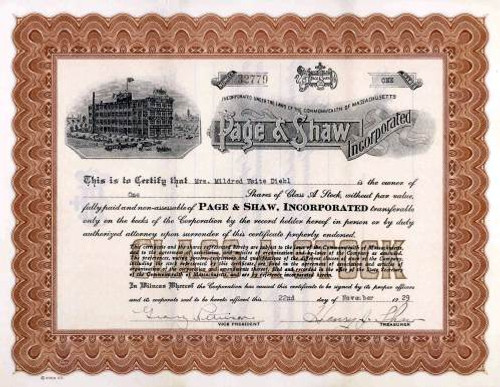Beautifully engraved SPECIMEN certificate from the Rayonier Incorporated. This historic document was printed by the Security-Columbian Banknote Company and has an ornate border around it with a vignette of a manufacturing plant between two allegorical men. This item has the printed signatures of the Company's President and Secretary. 
Certificate Vignette Company History: 1926: The Rainier Pulp and Paper Company was incorporated on the U.S. West Coast after our founders were the first to recognize an opportunity to use the area's plentiful, Western hemlock tree species for the production of a superior grade of bleached paper pulp. 1927: The company's first mill in Shelton, Washington went into production. 1931: Rainier research scientists teamed up with Du Pont, the leading producer of rayon, and perfected the world's first pulp made from hemlock designed especially for the growing rayon industry. 1937: Public trading began on the New York Stock Exchange after the company was incorporated as "Rayonier," a name created from the union of the word rayon with Mt. Rainier, the 14,410-foot mountain visible from the first mill site. At its founding, Rayonier already was the largest single maker of dissolving pulps in the world. 1938: The company began extending its reach to the East Coast with the purchase of Southeast U.S. timberlands. 1939: The first Southeast pulp mill was completed in Florida to utilize extensive resources acquired in timberland purchases in the region. 1945: Major timberland purchases began in the West. 1952: The Rayonier Foundation was formed to provide charitable contributions to civic, educational and charitable causes in local communities. 1954: A second Southeast pulp mill opened in Jesup, Georgia. Quick success led to a doubling of the size of the facility within three years to meet growing demand. The first international offices opened in Europe and Asia. 1963: Northwest foresters developed markets in the Far East for timber after a Columbus Day windstorm swept through the region. 1968: Rayonier became ITT Rayonier, a wholly owned subsidiary of ITT Corporation, a major international conglomerate. 1971: Further expansion of the Jesup Mill made it the largest facility of its kind in the world. 1980: Only one year after the restoration of diplomatic relations with China, Rayonier successfully established a customer base there for its U.S. pulp. 1985: Rayonier made an important, fundamental change in its timber business by selling timber to the highest bidder on a market-based auction system instead of transferring timber within the company at non-market based prices. 1992: Significant international expansion occurred when Rayonier acquired control over extensive timberlands in New Zealand. 1994: Rayonier once again became an independent public corporation in a spin-off from ITT and trading began on the New York Stock Exchange under the symbol RYN. 1995: Emphasis on pulp moved from the Northwest to the Southeast U.S. with the completion of a state-of-the art research facility in Jesup, Georgia. 1999: The company became the 7th largest private timberland owner in the U.S. as the company began a program to reposition the company for continued growth by acquiring 968,000 acres of timberland in Florida, Georgia and Alabama. 2000: Rayonier moved its corporate offices from Stamford, CT to Jacksonville, FL to capture the synergies of being in the Southeast U.S. where it has a significant majority of its employees and assets. The same year, the company announced a new focus on two core businesses with the highest potential for growth and financial return, Performance Fibers and Timber and Land.

Certificate Vignette








